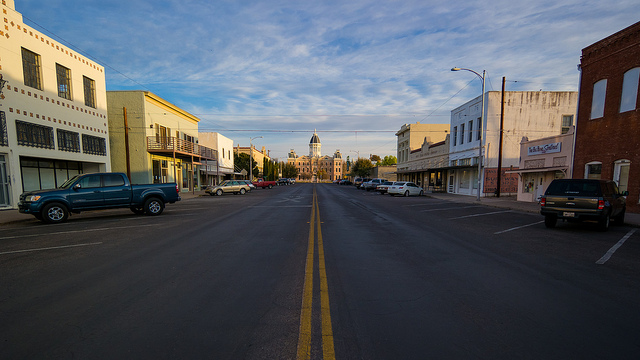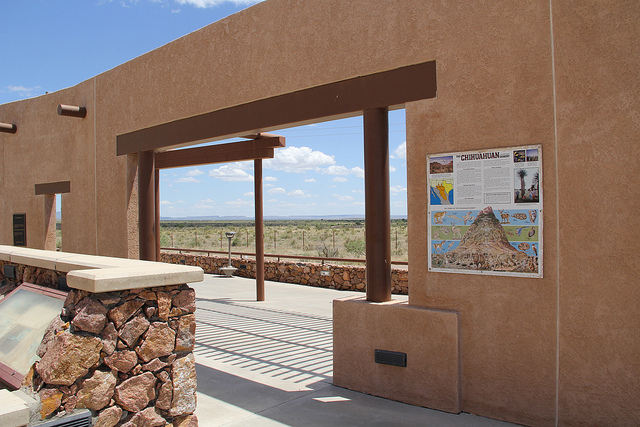Established in 1883 as a water stop for the San Antonio Railroad, this one-horse town has become an international destination for art lovers over the last few decades. In an area considered one of the last American frontiers, the town is still tiny, with a population of only 2,000. Yet minimalist art makes a maximum impact on this stark landscape. Industrial installations interrupt the dry, rocky terrain and desert scrub, framed under wide Texas skies, the occasional tumbleweed the only movement breaking up the still panoramas.

Marfa, Texas (Photo: Nan Palermo /Flickr)
Located on the high plains of the Chihuahua Desert, tucked between three mountain ranges with Big Bend National Park to the south, the nearest airport is three hours away. Marfa is far from anywhere, and with its down-home friendliness, it’s also far removed from the pretentious art scene you would find elsewhere. As the Marfa Visitor Center literature says: “Tough to get to. Tougher to explain. But once you get here, you get it.”
From railway pit stop to military base to art arena, Marfa has an interesting history. Its Army Airfield served as a training facility for several thousand pilots during World War II, but it closed soon after the war ended, also ending the economic boom. When the dust settled, the sleepy town was left to a handful of ranchers and cattle farmers. Up until the 1970s, Marfa was best known for its mysterious ghost lights and the film location for James Dean’s final picture, “The Giant,” filmed in the colonial style Hotel Paisano, still in operation—and a top choice for lodging.
An Artist’s Impact
All of that changed in 1971 when renowned artist Donald Judd up and moved to Marfa from New York City with the intention of permanently installing his art, putting the town on the map in the art realm. Judd acquired the decommissioned army base and began transforming the fort’s buildings into art spaces, inspiring the eventual cultural center for contemporary artists and artisans that it is today.
In recent years new galleries have opened downtown in and around the historic town square, and with them a plethora of restaurants and quirky hotels, along with residency programs, theaters and performance spaces. Located in a converted dance hall built in 1926, Ballroom Marfa is one of the hottest on the scene. Well-curated and popular with locals and tourists alike, the art space presents art films and hosts musical performances along with their biannual visual exhibits. In fact, the Ballroom Marfa helped support the Scandinavian artist duo Elmgreen & Dragset in creating the highly acclaimed Prada Marfa, a pop art exhibit about 35 miles from town that’s well worth a visit.

Prada Marfa (Photo: Ben Brown)
Since Judd’s death in 1994, the Chinati Foundation maintains his legacy offering both guided and self-guided tours at the old army base, which is still a large draw and now occupies more than ten buildings at the site and has permanent exhibits not only by Judd, but many other big name artists.
Emerging artists are encouraged with programs such as Fieldwork Marfa, the brainchild of two major European art schools, ESBA Nantes Métropole and HEAD Geneva. The international research-in residence program is dedicated to the practice of art in public space, critical approaches to landscape and artist projects intended for emerging artists, curators and researchers; six lucky artists are selected a year.
Yet you don’t have to be an acclaimed or aspiring artist to enjoy Marfa—there are events and festivals around town with broad appeal. July boasts both the Marfa Film Festival and Big Bend Music Festival. El Cosmico—probably the trendiest and most unique trailer park you will ever see—is not only a great place to stay but hosts events such as the Trans-Pecos Festival of Music and Love, Sunset Soundtracks featuring electronica DJs, and herbal workshops. The vintage trailers in silver, hot pink, and lime green are works of art in themselves. Though they have a retro seventies feel on the outside, inside they are quite high-end with birch interiors and designer furniture. Primitive yurts and authentic TPs are also available and camping is allowed on the site for the more adventurous.
The Mysterious Ghost Lights
The Marfa Lights Festival is on Labor Day weekend each year, but the ghost light phenomenon can be seen year round from an official viewing area nine miles east of Marfa. These mystifying lights warrant some explanation—although no real explanation exists. Often seen at dawn or dusk, or in the dead of night, reports describe multiple glowing basketball-sized spheres hovering across the night sky moving laterally at low speeds. Entirely inexplicable, critics have said they could be headlights from oncoming traffic—yet the lights were documented by Native Americans long before the invention of electricity.

Marfa Mystery Lights Viewing Platform. (Photo: T. Feuerborn)
The dominant theory is that these orbs of light are some sort of mirage caused by sharp temperature gradients between cold and warm pockets of air, but that theory has in no way been proven. When asked if it was an urban legend, Ellen Melvin, who works at the Visitor Center and was born and bred in Marfa, said she has been to the viewing area at least a hundred times, and of those visits there were only two times she didn’t see the lights.
The ghost lights only add to the community’s Old West ghost town feel, with hotels named The Stumble Inn, Casita West, and the famous Thunderbird. Marfa’s restaurants have gained attention in recent years, from both foodies and hipsters that prefer food trucks. The most famous is Food Shark, selling Mediterranean style street food including the popular Marfalafel. Mando’s Restaurant and Bar, serving freshly-made, mostly Mexican food, is a hole in the wall mom and pop joint, the best kind of restaurant for local flavor. Maiya’s offers consistently tasty New American Cuisine, and for a more upscale experience, choose Chochiveal, with rave reviews and the ambiance and quality of a big-city restaurant.
There is no bad time to visit; the weather is pleasant year round. Surrounded by mountains on a high plateau, Marfa is so secluded that it even has its own unique weather patterns—50-degree temperature spreads during 24 hours are common—with no humidity.
“It’s where the rest of Texas come to cool down and relax. Even in the hottest months of summer, being in the shade feels just like being in the air conditioning,” Ellen explained. With its major pieces of minimalistic art set in a sparse landscape, and music and culture in a laid-back environment with folksy hospitality, Marfa is a rare amalgam—and a sanctuary indeed.